#rey felipe v of spain
Explore tagged Tumblr posts
Text

El Rey Felipe V de España
Artist: Louis-Michel van Loo (French, 1707-1771)
Date: Circa 1739
Medium: Oil on Canvas
Location: Museo del Prado, Madrid, Spain
Louis-Michel van Loo
Louis-Michel van Loo was a french painter. He studied under his father, the painter Jean-Baptiste van Loo, at Turin and Rome, and he won a prize at the Académie Royale de Peinture et de Sculpture in Paris in 1725. With his uncle, the painter Charles-André van Loo, he went to Rome in 1727–1732, and in 1736 he became court painter to Philip V of Spain at Madrid, where he was a founder-member of the Royal Academy of Fine Arts of San Fernando in 1752.
He returned to Paris in 1753, and painted many portraits of Louis XV of France. In 1765 he succeeded Charles-André as director of the special school of the French academy known as the École Royale des Élèves Protégés. In 1766 he made the portrait of the Portuguese statesman Sebastião de Melo, Marquis of Pombal.
Among his brothers were the painters François van Loo (1708–1732) and Charles-Amédée-Philippe van Loo (1719–1795).
1 note
·
View note
Text
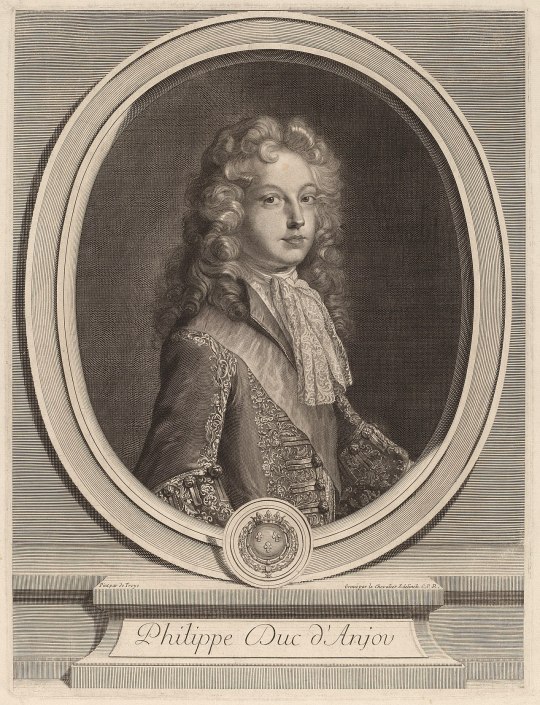
Philippe, Duke of Anjou (later King Felipe V of Spain). By Gerard Edelinck.
#gerard edelinck#royaume de france#maison de bourbon#philippe de bourbon#duc d'anjou#engraving#duke of anjou#kingdom of spain#kingdom of france#house of bourbon#casa de borbón#felipe v#rey de españa#viva el rey#françois de troy#fils de france#infant d'espagne#roi d'espagne#bourbon anjou
8 notes
·
View notes
Text




Through the Years → Felipe VI of Spain (2,597/∞) 17 April 2021 | King of Spain Felipe VI, President of Spain Pedro Sanchez, president Joan Laporta of FC Barcelona during the Spanish Copa del Rey match between Athletic de Bilbao v FC Barcelona at the La Cartuja Stadium in Sevila Spain (Photo by David S. Bustamante/Soccrates/Getty Images)
0 notes
Photo

Toilet Cabinet of Ferdinand VII in Madrid, Spain To his supporters, Ferdinand VII of Spain was known as el Deseado ("the Desired"). But to his detractors, the 19th-century king was known as el Rey Felón ("the Criminal King"). Ferdinand VII was an absolutist and unscrupulous king, always surrounded by a cabal of sycophants with politics that were geared largely toward his own survival. The only action of his reign for which we should be grateful was the conversion in 1819 of the Villanueva building, where the old Cabinet of Natural Sciences was located, into one of the best fine arts museums in the world, what is now known as the Prado Museum. In 1828, a restroom was installed at the Prado for the monarch and his family. The Rest Cabinet of His Majesties was kept hidden from the public for many years. In 2019, for the 200th anniversary of the museum, the restroom area was recreated in its original location, currently room 39 of the museum. They attempted to show, as faithfully as possible, the appearance this room had two centuries earlier, reproducing the cherry-toned colors of the walls at that time and gathering most of the paintings that hung on them. There were a total of 44 frames: portraits like The Family of Felipe V by Louis-Michel van Loo and works by Mengs and Tiepolo. As a self-respecting restroom, there had to be a shelter for the royals and their distinguished guest to relieve themselves. A small room (39A) still maintains the original decorations, as well as several objects intended for the grooming of his majesty. There are two commodes from the Royal Porcelain Factory of La Moncloa (one for men and one for women), a beautiful silver aquamanile, and a king's toilet case that includes colorful objects such as basins, glass glasses, toothbrushes, and more. The most curious object in this space is a curious piece of furniture: a luxurious latrine. The central part, where the toilet seat is placed, is made of mahogany and upholstered in velvet. There's a piece below that simulates a drawer, but it's actually an elongated door that opens on one side, leaving all the interior space free to allow access to a chamber pot that was removed by an attendant after use. This piece was made by the cabinetmaker Ángel Maeso González, one of the most important master craftsmen of the Royal Workshops, being completed in 1830. https://www.atlasobscura.com/places/fernando-vii-toilet-cabinet-prado
0 notes
Photo

@Neoprusiano Rey Felipe V de España Rex Philippus V Hispaniae König Philipp V. von Spanien King Philip V of Spain Roi Philippe V d'Espagne
Jean Ranc (1674-1735), 1723.
145 notes
·
View notes
Photo
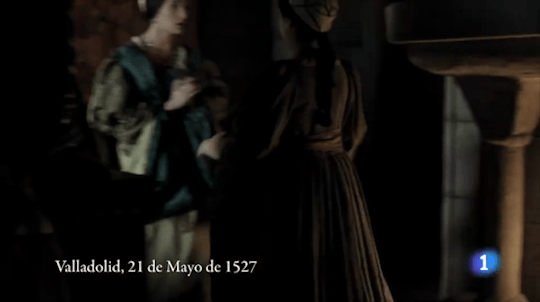


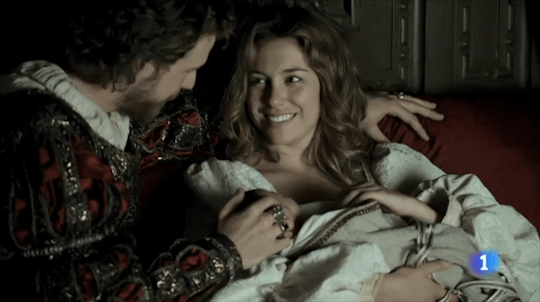


21 May 1527 - The Birth of Philip II of Spain
“As is often the case with a first child, the empress was in labour for many hours. She asked for a veil to be placed over her face, so that no one would see her agony; and when a midwife urged her to give full vent to her feelings the empress replied sternly: ‘I would rather die. Don’t talk to me like that: I may die, but I will not cry out.’ Philip entered the world around 4 p.m. on 21 May 1527. Many Spaniards had expected the prince to receive one of the traditional names of the peninsular dynasties, such as Fernando or Juan, but Charles insisted on calling his firstborn after his own father, and so at the baptism ceremony two weeks later the royal heralds shouted three times: ‘Philip, by the grace of God prince of Spain!’”
Geoffrey Parker, Imprudent King: A New Life of Philip II
El Rey.
Amados y fieles nuestros: A Nuestro Señor ha placido alumbrar a la serenísima Emperatriz, nuestra muy cara y amada muger, con un hijo, que parió a los XXI del presente. La qual, aunque ha pasado harto trabajo, queda ya, loores a Dios, muy buena. Plegará a la divina bondad que deste fructo que ha sido servido de darnos, succederá mucho servicio suyo, establecimiento de beneficio público y reposo de nuestros Reinos y señoríos.
Avisámosvos dello por vuestro contentanmiento y para que deis gracias a Dios por tanto beneficio.
Data en Valladolid a XXIII de Mayo de MDXXVII.
Yo, el Rey.
Philip’s birth announcement by Charles V, 23 May 1527. In Felipe II y su tiempo by Manuel Fernández Álvarez
#Philip II#Philip II of Spain#Charles V#Isabella of Portugal#Geoffrey Parker#¡Feliz cumpleaños Felipito!🥳#Ok ok I overuse that quote by Parker but this time in addition I have found Philip's birth announcement#also big thanks to Carlos Rey Emperador for giving us a proper Philip’s birth scene#sources
64 notes
·
View notes
Photo




Felipe and Letizia retrospective: September 27th
2004: Opening of the International Seminar on ‘Spain, Bridge between the European Union and Latin America’; Lunch offered to the President of Czhec Republic Vaclav Klaus and his wife Livia Klausova & Gala dinner offered to the President of Czhec Republic Vaclav Klaus and his wife Livia Klausova. (1, 2)
2007: Posthumous tribute to Don Rodrigo Uría
2010: Audiences at la Zarzuela
2012: Inauguration of the Tourism International Day 2012 in Gran Canaria; Visited La Gomera & Letizia on the cover of Tiempo magazine with other women that turned 40 in 2012 (1, 2)
2013: 25th anniversary of the class of 1988 in Pontevedra & Visited King Juan Carlos at Quiron Hospital
2015: Went out to dinner
2017: “4th edition of the Enrique V. Iglesias Prize for the Development of the Ibero-American Business Space” & Opened the Professional Training Course 2017/2018, in Teruel (1, 2)
2018: 3rd session of the Spain Trends Forum, organized by El País and the consultancy Kreab in Madrid & Opened the Professional Training Course 2018/2019, in Marratxí (1, 2)
2019: Visited the Museum of Aeronautics and Astronautics in Madrid, Presentation of the #Femtástica Project, created by the Foundation to Help Against Drug Addiction and Samsung & Visited Arganda del Rey in Madrid that was affected by the recent floods
2021: Received in Cascais by the president of Portugal, Marcelo Rebelo de Sousa, before he offered them a private lunch & Inaugurated the new “Botton-Champalimaud Pancreatic Cancer Centre”
F&L Through the Years: 837/??
#King Felipe#Queen Letizia#King Felipe of Spain#Queen Letizia of Spain#King Felipe VI#King Felipe VI of Spain#F&L Through the Years#September27
5 notes
·
View notes
Photo
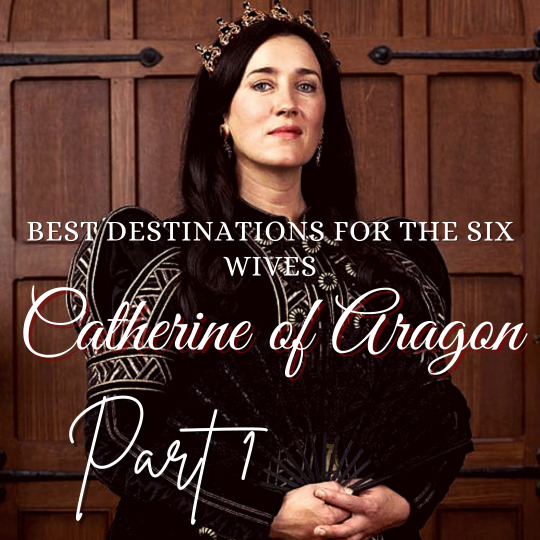
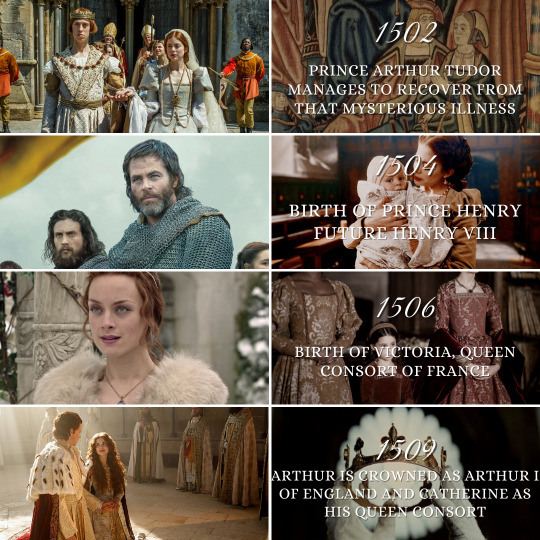
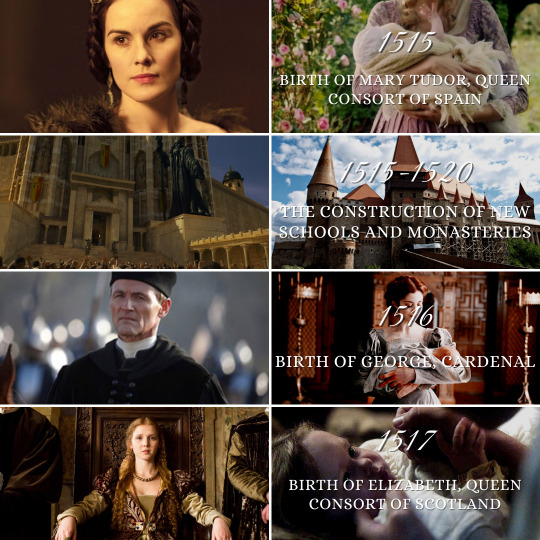
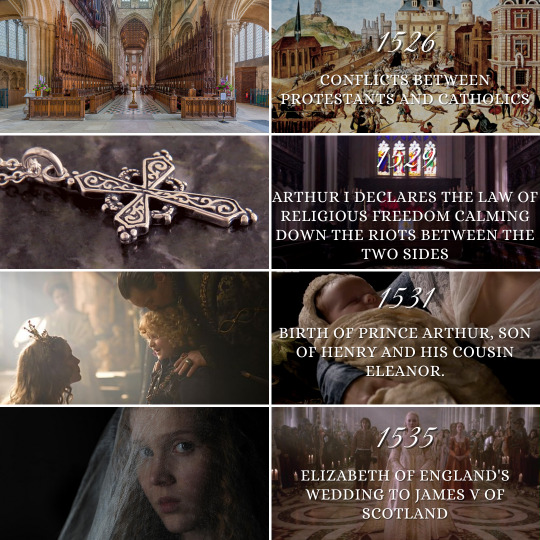

AU Tudor: Best Destinations for Henry VIII's Wives (That is, if they had never married him)
Catherine of Aragon-Queen of England (1485-1540)
Catherine and her husband, the Prince of Wales, Arthur Tudor were deeply in love and that great love was able to overcome the disease they were going through. The improvement of the princes was a great joy for all and the couple continued with their normal life, being a very united and passionate couple also focusing on the task of bringing children into the world. In 1504 the couple's first son, Henry, the future Henry VIII of England, was born. The birth of the little one was a great joy for England and for the kingdoms of Castile and Aragon, since the succession to the throne was assured. Two years later Princess Victoria was born, who would be Queen Consort of France.
In the year 1509 King Henry VII of England died and Arthur sat on the throne as Arthur I of England, Catherine being his consort. Dances and masses were held for the new kings wishing them a long life and many descendants. In 1515 the third daughter of the kings was born, Mary who became queen consort of Spain.
During the years 1515 and 1520 England was involved in numerous conflicts between Catholics and Protestants. King Arthur did not want to start a war of religion trying to appease both sides but to be a fervent Catholic like his queen. In that period, Catherine had two more children: George Tudor in 1516, who became a cardinal, and Elizabeth in 1517 who was Queen of Scotland; During Elizabeth's pregnancy, Arturo suffered an attack at gunpoint by a Protestant and this news greatly upset the queen, giving birth to her daughter prematurely.
In the year 1523 Arthur and his little brother, Henry the Duke of York, made the passes after ten years of estrangement, in addition to promising the Prince of Wales, Henry, with his older cousin, Eleanor. A year later both cousins were married in the Church of Greenwich in a simpler but happy ceremony.
In 1525, Princess Victoria married King Francis I of France shortly after Claudia de Valois' widow. This marriage managed to make peace between France and England.
In the year 1526 there was a revolt between the religious groups resulting in the death of more than two thousand people. This event was known as "the massacre for Christ" being a great tragedy for the kings who tirelessly searched for the perpetrators of the massacre.
In the year 1527 the first daughter of the princes of Wales was born, Catherine who was Duchess of Orleans. A year later she was born Margaret, but she died of smallpox at the age of seven.
Three years later in 1529 the king declared the law of free religion respecting the religions of every inhabitant of England, Arthur being known as "The Conciliator". Despite the fact that Catherine was a fervent Catholic, she respected the Protestant side and did not include religion in the issues of State.
In 1531 Prince Arthur was born, the first son of Prince Henry and his wife Eleanor, this birth being a great joy for all England. A year later another son was born, Luis who would be Duke of Cornwall, the duchy being separated from the title of Prince of Wales.
At first, Princess Mary was betrothed to her cousin, Carlos I of Spain, but he broke off his commitment to marry Isabel of Portugal, having numerous tensions between England and Spain, but the Spanish king proposed to marry his cousin with his son, the Prince of Asturias, Felipe. This engagement did not please the kings very much due to the twelve years difference between the young people, but in the end they agreed to marry in the year 1532.
In 1535 Arthur and his sister Margaret decided to marry his sons James V of Scotland and Elizabeth of England to each other. That same year the couple got married and Elizabeth was crowned Queen of Scotland in this way both countries signed peace.
In the year 1539 Catherine suffered a relapse while returning from a mass, this caused her to stay in bed for several months in which her condition began to worsen more and more, but she remained strong for her country and her husband who did not detached from his queen from the start. One year after complete agony and grief, Queen Catherine of Aragon passed away at the age of 55. It is said that on her deathbed, she hugged her husband, who was devastated when he saw her beloved wife dead in her arms. Catherine's death was felt in much of Europe and she was remembered as a faithful, charitable queen and a great mother.
Catherine was buried in St George's Chapel at Windsor Castle. Just four days after the queen's funeral, Arthur I fell seriously ill and the next day he passed away at the age of 54. The king's last words were "my beloved Catalina."
AU Tudor: Los mejores destinos para las esposas de Henry VIII (Es decir si ellas nunca se hubieran casado con el)
Catalina de Aragón-Reina de Inglaterra (1485-1540)
Catalina y su esposo, el príncipe de gales, Arturo Tudor estuvieron enamorados profundamente y ese gran amor pudo contra la enfermedad por la que estaban pasando. La mejoría de los príncipes fue una gran alegría para todos y la pareja siguió con su vida normal, siendo una pareja muy unida y pasional centrándose también en la tarea de traer hijos al mundo. En el año 1504 nació el primer hijo de la pareja, Henry el futuro Henry VIII de Inglaterra. El nacimiento del pequeño fue una gran alegría para Inglaterra y para los reinos de Castilla y Aragón, ya que la sucesión del trono estaba asegurada. Dos años después nació la princesa Victoria que sería reina consorte de Francia.
En el año 1509 falleció el rey Enrique VII de Inglaterra y Arturo se sentó en el trono como Arturo I de Inglaterra siendo Catalina su consorte. Se celebraron bailes y misas por los nuevos reyes deseándoles una larga vida y muchos descendientes. En el 1515 nació la tercera hija de los reyes, María que se convirtió en reina consorte de España.
Durante los años 1515 y 1520 Inglaterra se vio envuelta en numerosos conflictos entre católicos y protestantes. El rey Arturo no quería iniciar una guerra de religión tratando de apaciguar a ambos bandos pece a ser un ferviente católico como su reina. En ese periodo Catalina tuvo dos hijos mas: George Tudor en el año 1516, quien se convirtió en cardenal, e Isabel en el año 1517 quien fue reina de Escocia; Durante el embarazo de Isabel, Arturo sufrió un ataque a punta de pistola por parte de un protestante y esta noticia altero mucho a la reina dando a luz a su hija de manera prematura.
En el año 1523 Arturo y su hermano pequeño, Enrique el duque de York hicieron las pases después de diez años de distanciamiento, además de prometer al príncipe de Gales, Enrique con su prima mayor, Leonor. Un año después ambos primos se casaron en la Iglesia de Greenwich en una ceremonia mas sencilla, pero feliz.
En el 1525 la princesa Victoria se caso con el rey Francisco I de Francia poco después que este enviudara de Claudia de Valois. Este matrimonio logro hacer la paz entre Francia e Inglaterra.
En el año 1526 hubo una revuelta entre los bandos religiosos resultando en la muerte de mas de dos mil personas. Este acontecimiento fue conocido como “la masacre por Cristo” siendo una gran tragedia para los reyes quienes buscaron incansablemente a los perpetradores de la masacre.
En el año 1527 nació la primera hija de los príncipes de Gales, Catalina que fue duquesa de Orleans. Un año después nació Margaret, pero falleció de viruela a los siete años.
Tres años después en el 1529 el rey declaro la ley de libre religión respetando las religiones de cada habitante de Inglaterra, siendo Arturo conocido como “El conciliador”. Pesé a que Catalina era una ferviente católica ella respeto al bando protestante y no incluía la religión en los temas de Estado.
En el 1531 nació el príncipe Arturo, el primer varón del príncipe Enrique y su esposa Leonor, siendo este nacimiento una gran alegría para toda Inglaterra. Un año después nació otro hijo varón, Luis que sería duque de Cornualles siendo el ducado separado del titulo de príncipe de Gales.
En un principio la princesa María fue prometida con su primo, Carlos I de España, pero este rompió su compromiso para casarse con Isabel de Portugal teniendo numerosas tenciones entre Inglaterra y España, pero el rey español propuso casar a su prima con su hijo, el príncipe de Asturias, Felipe. Este compromiso no gusto mucho a los reyes debido a los doce años de diferencia entre los jóvenes, pero al final accedieron al casamiento en el año 1532.
El 1535 Arturo y su hermana Margarita decidieron casar a sus hijos Jacobo V de Escocia e Isabel de Inglaterra entre si. Ese mismo año la pareja se caso e Isabel fue coronada como reina de Escocia de esta manera ambos países firmaron la paz.
En el año 1539 Catalina sufre una recaída mientras regresa de una misa, esto provoca que se quede en cama por varios meses en los cuales su estado empieza a empeorar cada vez mas, pero se mantiene fuerte por su país y su marido quien no se a despegado de su reina desde el comienzo. Un año después de completa agonía y pena, la reina Catalina de Aragón falleció a la edad de 55 años. Se dice que en su lecho de muerte abrazo a su marido el cual quedo destrozado al ver a su amada esposa muerta en sus brazos. La muerte de Catalina fue sentida en gran parte de Europa siendo recordada como una reina fiel, caritativa y una gran madre.
Catalina fue enterrada en La Capilla de San Jorge, en el Castillo de Windsor. Tan solo cuatro días después del funeral de la reina, Arturo I callo enfermo de gravedad y al día siguiente falleció a la edad de 54 años de edad. Las ultimas palabras del rey fueron “mi amada Catalina”.
#catherine of aragon#arthur tudor#arthur i of england#henry viii#victoria of england#mary of england#george of england#elizabeth of england#house tudor#AU
64 notes
·
View notes
Photo
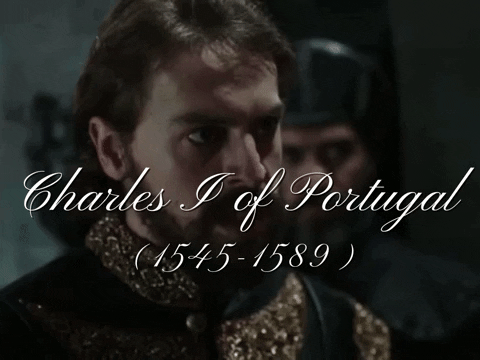
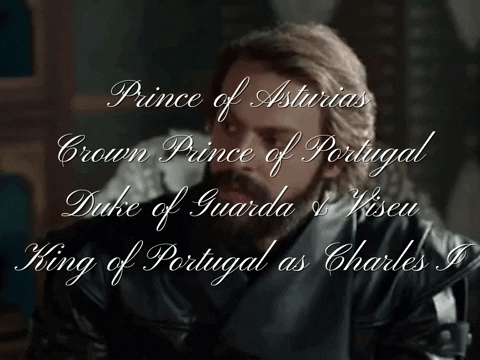
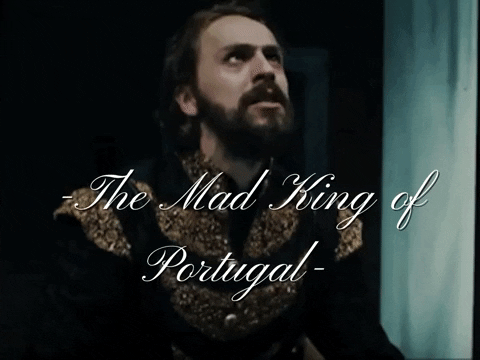
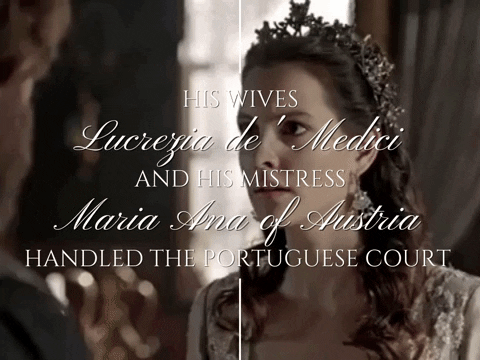
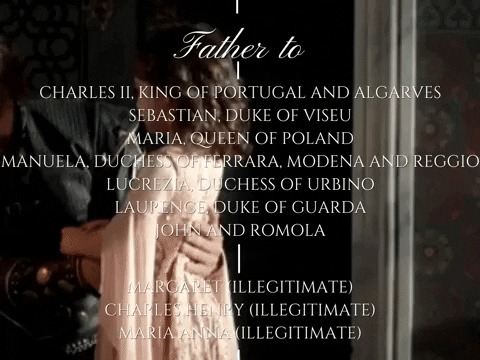
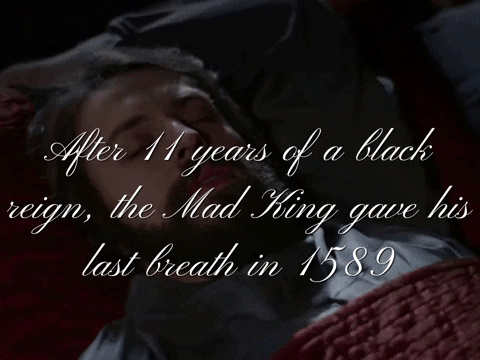
𝙻𝙾𝚂 𝙷𝙸𝙹𝙾𝚂 𝙳𝙴 𝙵𝙴𝙻𝙸𝙿𝙴 𝙸𝙸 𝙳𝙴 𝙴𝚂𝙿𝙰Ñ𝙰-𝙲𝙰𝚁𝙻𝙾𝚂 𝙸 𝙳𝙴 𝙿𝙾𝚁𝚃𝚄𝙶𝙰𝙻
Carlos de Austria y Avis fue el único hijo de Felipe de Austria futuro Felipe II de España con su primera esposa María Manuela de Portugal que era princesa de Portugal. Su madre falleció tras darlo a luz y fue criado por sus tías las infantas María y Juana, pero esta ultima llegaría a ser su favorita y quien mas lo cuido tras marcharse María a Viena para casarse con el archiduque Maximiliano.
Tras su tía Juana marcharse a Portugal para casarse con el príncipe Juan Manuel, Carlos se quedaría con algunos familiares cercanos y no vio a su padre por largos periodos de tiempo. Carlos empezó a desarrollar sus primeros juegos sádicos lastimando a animales pequeños y causando numerosas travesuras peligrosas.
Carlos fue educado en la Universidad de Alcalá de Henares junto al medio hermano del rey don Juan de Austria y su primo hermano Alejandro Farnesio. Sin embargo no fue un buen estudiante y llego a ser una gran vergüenza para su padre.
En un principió el príncipe estaba comprometido con la princesa francesa Isabel de Valois, pero esta acabaría casándose con su padre tras este divorciarse en 1558 de la reina María I de Inglaterra. Tras su fallido compromiso se le busco una nueva prometida y varios nobles ofrecieron a sus hijas, entre ellos el Duque de Florencia Cosme de Medici que ofreció 3 retratos de sus 4 hijas: Lucrecia, Ana y Juana. Carlos se decanto por Lucrecia debido a que le parecía una joven guapa, sumisa y con un aspecto delicado.
La boda entre Carlos y Lucrecia se celebro a principios del 1560 teniendo los prometidos 14 años en el momento de la unión, además de ser nombrados príncipes de Asturias. El matrimonio fue consumado pese a que Lucrecia aun no menstruaba y Carlos llego a decir que le encantaba como su esposa chillaba, gemía y gritaba cuando la penetraba resultándole muy satisfactorio.
Lucrecia no se quedaría embarazada hasta 1561 pese a que los príncipes compartían el lecho hasta 4 veces por noche. Pese a la débil salud de Carlos el y su esposa tuvieron 8 hijos en común:
Carlos II de Portugal (1561-1631) Fue rey de Portugal y segundo rey de la Dinastía Austria. Carlos es conocido como “El testarudo” por su lucha inalcanzable por tener el trono español, pero nunca lo conseguiría. Se caso en dos ocasiones, en primeras nupcias se caso con la archiduquesa María Ana de Habsburgo y tuvieron 3 hijas: Ana, María y Carolina. Al enviudar en 1591 se caso con Ana de Suecia y tuvieron 5 hijos: Carlos III, Enrique, Juan, Fernanda y Renata.
Sebastián de Viseu (1563-1640) Fue Duque de Viseu como segundo hijo y fue conocido como “La serpiente portuguesa” por sus numerosas intrigas palaciegas y pasando entre los bandos de su hermano Carlos II y su tío Enrique V de España. Se caso con su prima Romola de Medici y tuvieron 3 hijos: Renato, Claudia y Manuela. Tras divorciarse en 1599 se caso con su amante Maria de Mendoza y Maria de Silva con la cual ya tenia 6 hijos ilegítimos entre ellos Juan de Viseu.
María de Portugal (1564-1608) Fue Reina consorte de Polonia al ser la segunda esposa de su primo Segismundo III Jagellon y tuvieron 5 hijos: Alejandro, María Casimira, Carlota, Ana Joaquina y Fernando. Murió debido a la tuberculosis.
Manuela de Portugal (1566-1639) Fue duquesa de Ferrara, Modena y Reggio al casarse con Alfonso III de Este, único hijo de Alfonso II. Manuela le dio a su marido 8 hijos: Manuela Catalina, María Enriqueta, Alfonso IV, niño mortinato, Cecilia, Lucrecia, Federico y Antonio.
Lucrecia de Portugal (1569-1610) Fue Duquesa de Urbino al ser la primera esposa de Francesco Maria II della Rovere y tuvieron 2 hijos: Francisco Maria III y Enrique Fernando. Lucrecia falleció a los 41 años por la viruela.
Lorenzo de Guarda (1570-1599) Fue Duque de Guarda por herencia y desempeño una carrera militar. Se caso con Anna Juliana Gonzaga y tuvieron dos hijas: Juliana María y María Teodora. Fue asesinado a los 29 años por unos ladrones mientras regresaba de una noche en taberna.
Juan de Portugal (1572-1575) Fue el ultimo hijo de los reyes y gemelo de Romola. Fue un niño muy delicado y acabo falleciendo a los 3 años de edad.
Romola de Portugal (1572-1582) Fue la gemela de Juan. Su padre decidió que debía convertirse en monja, pero durante su etapa como novicia Romola enfermo de viruela y falleció a los 10 años de edad.
Durante los embarazos de su esposa, Carlos mantuvo varias relaciones extramatrimoniales con sirvientas y prostitutas, teniendo probablemente algunos hijos ilegítimos, pero solo reconoció a dos de estos:
Margarita (1565-1640) Fue condesa consorte de Belchite al casarse con Juan Francisco Cristóbal Fernández de Híjar y Fernández de Heredia con el cual tuvo 8 hijos.
Carlos Enrique (1571-1612) Fue un destacado militar y Duque de Guimarães siendo llamado “el duque bastardo”. Se caso con María de Braganza, hija del Duque Juan I de Braganza y con ella tuvo 5 hijos. Tras su muerte su hijo, Jaime le fue arrebatado el Ducado de Guimarães y le fue entregado el titulo de Conde de Vizela.
Carlos tuvo infinidad de relaciones extramatrimoniales aun que siempre se supo que sentía una gran debilidad por su esposa y conforme sus problema mentales iban aumentando mas se volvía un esposo fiel. El príncipe llego a ser muy impopular por su amor por la tortura y las artes amatorias. Una de sus mayores leyendas negras fue la que cuenta que mantuvo un romance con su tía favorita Juana de Austria cuando esta regreso a España tras enviudar del príncipe Juan Manuel de Portugal. Sin embargo esta leyenda termino cuando Felipe II de España caso a su hermana en 1559 con Constantino de Braganza y tuvo 3 hijos con el.
En 1576 Sebastián I de Portugal nombro a Carlos como su heredero en el trono portugués debido a que el rey se negaba a casarse. El príncipe se mostro ansioso por portar la corona portuguesa al ser hijo de María Manuela de Portugal, pero Felipe II aprovecho esta oportunidad para forzar a su hijo a dejar su titulo como Príncipe de Asturias y heredero al trono español a cambio de ser rey de Portugal. Carlos acepto de mala gana renunciar a la corona de España debido a que quería ser rey y sabía que tenia mas posibilidades de fallecer antes que su padre.
El 13 de noviembre del 1576 fue nombrado príncipe heredero de Portugal junto a su esposa. Sin embargo el pueblo no lo quería a un extranjero como su futuro rey, empezando a ser llamado en un principio “El indeseado”. Tras casi dos años de ser príncipe heredero de Portugal, el rey Sebastián I de Portugal falleció supuestamente en 1578 durante la batalla de Alcazarquivir.
Carlos fue coronado como Carlos I de Portugal en Lisboa junto a su esposa que seria su Reina consorte. Una de las primeras decisiones que tomo fue el de desterrar a su tío abuelo Enrique de Portugal que deseaba quedarse con el trono portugués e incluso se dice que pudo mandar a envenenarlo para quitárselo de en medio, pero el cardenal acabaría falleciendo un año después por causas naturales.
Su reinado fue conocido como “El gobierno del Loco” debido a la gran cantidad de damas bellas que se encontraban en la corte, además de que se implemento los castigos de tortura por cualquier crimen hacia la corona. Carlos fue conocido El rey loco de Portugal ya que mientras avanzaba el tiempo mas era su inestabilidad mental, siendo muy frecuente que llegase a golpear a sus criados y a sus amantes e incluso se cree que asesino cruelmente a una de estas mientras intimaban al ahorcarla con una sabana.
En 1584 llego a la corte portuguesa su prima María Ana de Austria y Mendoza que era la hija ilegitima de su tío Don Juan de Austria. Carlos se obsesiono con su prima y la saco del convento donde había crecido para convertirla en su amante. Aquella relación fue un absoluto escandalo debido a que ambos eran primos paternos, además de ser María Ana una hija ilegitima de un hijo legitimado. Pero al rey poco le importo y le entrego a su joven amante el viejo Señorío de Cadaval, además de darle algunos regalos.
María Ana y Lucrecia de Medici entablaron una buena relación e incluso se dice que entre los reyes y la amante del rey mantuvieron un trío o incluso se llego a pensar que María Ana complacía tanto al rey como a la reina en sus aposentos. Pese a estos rumores la reina y la amante oficial manejaron al rey siendo ellas las que mandaban en la corte lusa, además de atender los asuntos de estado mientras que Carlos I se entregaba a los placeres de la vida.
La amante oficial alumbro a una hija del rey:
María Ana de Portugal (1588-1648) Fue condesa de Tentúgal y marquesa consorte de Ferreira al casarse con Francisco de Melo con el cual tuvo 12 hijos.
Tras el nacimiento de su ultima hija ilegitima, Carlos se distancio de María Ana y esta acabaría casándose con Miguel Luís que era conde de Alcoutim y sexto marques de Vila Real con el cual tuvo 7 hijos.
Carlos llevaba varios años padeciendo de gota y de continuos dolores de cabeza siempre poniéndose de mal humor, además de tener insoportables dolores. Su condición siguió empeorando permaneciendo por varios días en cama y siendo cuidado por su esposa que nunca se aparto de el. El rey dicto su testamento en sus pocos momentos de cordura repartiendo sus dominios entre sus hijos y dejándole a su mujer una gran suma de dinero como agradecimiento por haber estado siempre con el.
Carlos I de Portugal falleció a los 44 años de edad supuestamente por sus continuos ataques de gota o por que el mismo bebió una copa de vino que contenía arsénico muriendo en cuestión de segundos. Fue sucedido por su hijo Carlos II y la Dinastía Austria seguiría reinando por 8 generaciones mas hasta el reinado de Carlota I de Portugal que seria su descendiente.
𝚃𝙷𝙴 𝙲𝙷𝙸𝙻𝙳𝚁𝙴𝙽 𝙾𝙵 𝙿𝙷𝙸𝙻𝙸𝙿 𝙸𝙸 𝙾𝙵 𝚂𝙿𝙰𝙸𝙽-𝙲𝙷𝙰𝚁𝙻𝙴𝚂 𝙸 𝙾𝙵 𝙿𝙾𝚁𝚃𝚄𝙶𝙰𝙻
Charles of Austria and Avis was the only son of Felipe of Austria future Philip II of Spain with his first wife María Manuela of Portugal who was princess of Portugal. His mother died after giving birth to him and he was raised by his aunts the infantas María and Juana, but the latter would become his favorite and the one who cared for him the most after Maria left for Vienna to marry Archduke Maximilian.
After his aunt Juana left for Portugal to marry Prince Juan Manuel, Carlos would stay with some close relatives and did not see his father for long periods of time. Carlos began to play his first sadistic games by hurting small animals and causing numerous dangerous mischiefs.
Charles was educated at the University of Alcalá de Henares together with the half brother of King Juan of Austria and his first cousin Alexander Farnese. However, he was not a good student and he became a great shame to his father.
In the beginning, the prince was engaged to the French princess Elisabeth of Valois, but she would end up marrying her father after he divorced Queen Mary I of England in 1558. After his failed engagement, a new fiancee was sought for him and several nobles offered his daughters, among them the Duke of Florence Cosimo de' Medici who offered 3 portraits of his 4 daughters: Lucrezia, Anna and Juana. Charles opted for Lucrezia because he thought she was a pretty, submissive young woman with a delicate appearance.
The wedding between Charles and Lucrezia was celebrated at the beginning of 1560 having the promised 14 years at the time of the union, in addition to being named princes of Asturias. The marriage was consummated despite the fact that Lucrezia still did not menstruate and Charles went on to say that she loved how her wife screamed, moaned and screamed when she penetrated her, finding it very satisfactory.
Lucrezia would not get pregnant until 1561 despite the princes sharing the bed up to 4 times a night. Despite Charles's weak health, he and his wife had 8 children in common:
Charles II of Portugal (1561-1631) He was king of Portugal and second king of the Austrian Dynasty. Carlos is known as "El stubborn" for his unattainable struggle to have the Spanish throne, but he would never achieve it. He married twice, in the first nuptials he married Archduchess María Ana de Habsburgo and they had 3 daughters: Ana, María and Caroline. When he was widowed in 1591 he married Ana of Sweden and they had 5 children: Charles III, Henry, John, Fernanda and Renee.
Sebastián of Viseu (1563-1640) He was Duke of Viseu as second son and was known as "The Portuguese Serpent" for his numerous palace intrigues and passing between the sides of his brother Charles II and his uncle Henry V of Spain . He married his cousin Romola de Medici and they had 3 children: Renato, Claude and Manuela. After divorcing in 1599, he married his mistress Maria de Mendoza and Maria de Silva, with whom he already had 6 illegitimate children, including John of Viseu.
María of Portugal (1564-1608) was Queen consort of Poland as the second wife of her cousin Sigismund III Jagellon and they had 5 children: Alexander, María Casimira, Charlotte, Anna Joaquina and Ferdinand. She died due to tuberculosis.
Manuela of Portugal (1566-1639) She was Duchess of Ferrara, Modena and Reggio when she married Alfonso III of Este, the only son of Alfonso II. Manuela gave her husband 8 children: Manuela Catalina, María Enriqueta, Alfonso IV, stillborn child, Cecilia, Lucrezia, Frederick and Antonio.
Lucrezia of Portugal (1569-1610) She was Duchess of Urbino as she was the first wife of Francesco Maria II della Rovere and they had 2 children: Francisco Maria III and Enrique Fernando. Lucrecia died at the age of 41 from smallpox.
Lorenzo of Guarda (1570-1599) He was Duke of Guarda by inheritance and a military career. He married Anna Juliana Gonzaga and they had two daughters: Juliana María and María Teodora. He was murdered at the age of 29 by robbers while returning from a night in a tavern.
John of Portugal (1572-1575) He was the last son of the kings and twin of Romola. He was a very delicate child and he ended up passing away at 3 years of age.
Romola of Portugal (1572-1582) was the twin of John. Her father decided that she should become a nun, but during her stage as a novice Romola was ill with smallpox and passed away at the age of 10.
During the pregnancies of his wife, Charles had several extramarital affairs with maids and prostitutes, probably having some illegitimate children, but he only recognized two of these:
Margaret (1565-1640) she was Countess consort of Belchite when she married Juan Francis Christóbal Fernández de Híjar and Fernández de Heredia with whom she had 8 children.
Charles Henry (1571-1612) He was a prominent military man and Duke of Guimarães being called “the bastard duke”. He married María of Braganza, daughter of Duke Juan I de Braganza and with her he had 5 children. After his son's death, Jaime was taken from him by the Duchy of Guimarães and he was given the title of Count of Vizela.
Charles had countless extramarital affairs even though it was always known that he felt a great weakness for his wife and as his mental problems increased, he became a faithful husband. The prince became very unpopular because of his love of torture and the lovemaking arts. One of his greatest black legends was that he had an affair with her favorite aunt Juana de Austria when she returned to Spain after being widowed by Prince Juan Manuel of Portugal. However, this legend ended when Felipe II of Spain married his sister in 1559 with Constantine of Braganza and had 3 children with him.
In 1576 Sebastián I of Portugal named Charles as his heir to the Portuguese throne because the king refused to marry. The prince was eager to wear the Portuguese crown as he was the son of María Manuela of Portugal, but Felipe II took this opportunity to force his son to give up his title as Prince of Asturias and heir to the Spanish throne in exchange for being King of Portugal. . Charles reluctantly agreed to give up the crown of Spain because he wanted to be king and knew that he had a better chance of dying before his father.
On November 13, 1576, he was named Crown Prince of Portugal along with his wife. However, the people did not want a foreigner like his future king, beginning to be called "The unwanted one" at first. After almost two years of being Crown Prince of Portugal, King Sebastián I of Portugal supposedly died in 1578 during the Battle of Alcazarquivir.
Charles was crowned Charles I of Portugal in Lisbon with his wife who would be his Queen consort. One of the first decisions he made was to banish his great-uncle Enrique from Portugal, who wanted to stay with the Portuguese throne and it is even said that he could have him poisoned to get him out of the way, but the cardinal would end up dying a year later due to causes. natural.
His reign was known as "The government of the Fool" due to the large number of beautiful ladies who were at court, in addition to the punishment of torture for any crime against the crown. Charles was known The Mad King of Portugal since as time progressed, his mental instability was more, being very frequent that he hit his servants and his lovers and it is even believed that he cruelly murdered one of these while they intimidated by hanging her with a sheet.
In 1584 his cousin María Ana de Austria y Mendoza, who was the illegitimate daughter of his uncle Don Juan de Austria, arrived at the Portuguese court. Charles became obsessed with her cousin and took her out of the convent where he had grown up to make her her lover. That relationship was an absolute scandal because both were paternal cousins, in addition to being María Ana an illegitimate daughter of a legitimate son. But the king cared little for me and he gave his young mistress the old Señorío de Cadaval, in addition to giving her some gifts. Maria Ana and Lucrezia de Medici established a good relationship and it is even said that between the kings and the king's mistress they had a trio or it was even thought that Maria Ana pleased both the king and the queen in her chambers. Despite these rumors, the queen and the official mistress managed the king, they being the ones who ruled the Portuguese court, in addition to attending to state affairs while Charles I indulged in the pleasures of life.
The official mistress gave birth to a daughter of the king:
María Ana de Portugal (1588-1648) she was Countess of Tentúgal and Marchioness consort of Ferreira when she married Francisco de Melo with whom she had 12 children.
After the birth of her last illegitimate daughter, Charles distanced himself from María Ana and she would end up marrying Miguel Luís who was count of Alcoutim and sixth marquess of Vila Real with whom she had 7 children.
Charles had been suffering from gout and continuous headaches for several years, always getting in a bad mood, in addition to having excruciating pain. His condition continued to worsen by staying for several days in bed and being cared for by his wife who never left his. The king dictated his will in the few moments of sanity, dividing his dominions among his children and leaving his wife a large sum of money as thanks for having always been with his.
Charles I of Portugal died at the age of 44, supposedly due to his continuous attacks of gout or because he himself drank a glass of wine that contained arsenic, dying in a matter of seconds. He was succeeded by his son Charles II and the Austrian Dynasty would continue to reign for 8 more generations until the reign of Charlotte I of Portugal who would be his descendant.
#carlos de austria#charles of austria#philip ii of spain#Maria Manuela de Portugal#maria manuela of portugal
9 notes
·
View notes
Audio
April 25th 1707 is one of the most important days in our history, and is commemorated annually as a day of fight for national liberation of the Valencian Country.
The Valencian band Al Tall perfectly summed up in a song the events that led to this date. Here’s the lyrics in Valencian-Catalan and the translation to English.
Va ser a la tardor de 1705, que a Altea desembarca Baptista Basset com a general de l'exèrcit de Carles el d'Àustria. Entra en la Marina i passeja per pobles i viles i en moltes comarques als maulets va distribuint armes i donant raons, convencent a tots els llauradors que l'Àrxiduc Carles ha promès suspendre tributs i gravàmens i tot el país li va plantar cara al borbó Felip V.
It was in autumn 1705 when Baptista Basset disimbarked in Altea as a general in the army of Charles of Austria. He entered la Marina area and walked in all towns and cities and in many shires, he distributed weapons to the maulets [armed groups of lower class agricultural workers who fought against Castilles’s rule on Valencia and for the rights of commoners against the nobility] and giving reasons, convinving all the farm workers that Archduke Charles had promised to eliminate all tributes and taxes and the whole country confronted the Bourbon Philip V.
Els reis i governants de tota Europa es posen a l'aguait i al ple s'aboquen, que està en discussió la corona dels regnes d'Espanya i els dos aspirants una guerra van a provocar, buscant aliances amb altres estats dos exèrcits preparen, Felip de Borbó i Carles d'Àustria, tals són els seus noms.
The kings and governors of all Europe start to keep watch and completely pour themselves into it, for the crown of the kingdoms of Spain is in discussion and the two candidates are about to provoke a war, looking for alliances with other states, they prepate two armies. Philip of Bourbon and Charles of Austria: these are their names.
Als pobles van renàixer les esperances d'arrancar el poder als nobles senyors i en poques setmanes el camí de València aplanaren; maulets i aliats dominaren pobles i ciutats; d'una punta a l'altra el país va tornar a obrir les arques per traure al carrer les senyeres contra el botifler i l'Arxiduc Carles a la porta de Quart aclamaren i ell feu jurament d'obeir i defendre las lleis.
In the villages, the hopes were reborn of striping away the power from the noble lords and in few weeks, they left the road to València flat maulets and allies dominated towns and cities; from one side to the other, the country again opened the chests to bring out the senyeres to the streets against the botifler [Philip V and his supporters]. And the Archduke Charles was acclaimed in the gates of Quart and he swore to obey and defend the laws [one of the reasons for the war was that the people from the Aragonese kingdoms -Valencia, Catalonia, Mallorca and Aragon- wanted to preserve their laws, and Castille wanted to impose its absolutist laws and customs on everyone else, which was a huge step back for the rights and living conditions of the lower classes, as well as of the whole countries, who would become invaded territory of Castile]
Del dia que ara esmente guardeu memòria: el 25 d'Abril de 1707 que trista batalla va somoure la terra d'Almansa; l'exèrcit borbó al de l'Àustria va vèncer d'un colp i sense defenses ocuparen comarques senceres. Mal dia va nàixer qui ordenà destruccions i matances. Si el mal ve d'Almansa amb raó diuen que a tots alcança: no es pot oblidar que en la boca del poble ha quedat.
Remember the day that I now say: the 25th of April of 1707 when the sad battle agitated the land of Almansa; the Bourbonic army defeated the Austriacist one and without defenses left, they [Bourbonics] occupied whole shires. May he be cursed [literally “Bad day was he born”] he who ordered destructions and massacres! If evil/pain comes from Almansa, they are right to say that it reaches everyone: it can’t be forgotten that it has remained in the mouth of the people. [“When evil/pain comes from Almansa, it reaches everyone” is a popular saying in Valencian. Almansa was the first defeat of the Valencians and it served as the entrance door for the Bourbonic armies to occupy all the Kingdom of València]
Després que va sotmetre tot el país i va tractar els hòmens amb gran crueltat, pensà que era l'hora d'augmentar el poder de la seua corona i sense tardança promulgà el Decret de Nova Planta, pel qual suprimia les lleis i costums de la pràctica antiga i ens va prohibir que parlàrem la llengua d'ací.
After he forced into submission the whole country and treated men with great cruelty he thought it was time to increase the power of his crown and without delay promulgated the Decrete of Nova Planta which suppressed the laws and customs of the old practise [banned the traditional laws of Valencia and the other kingdoms it occupied and forced everyone to have the Castillian ones, which gave the king absolute power] and he forbid us to speak the language from here.
Senyors i senyores, de la història us hem fet el reconte; si voleu seguir, en els llibres està tot escrit.
Ladies and gentlemen, we have told the history; if you wish to continue, it’s all written in the books.
#història#al tall#música#arts#país valencià#history#music#folk#folk music#25 d'abril#april 25th#today in history#history of europe#valencia#war of the spanish succession
21 notes
·
View notes
Text
15th King of Portugal (6th of the Aviz Dynasty): King João III of Portugal, “The Pious/ The Colonizer”

Reign: 13 December 1521 – 11 June 1557 Acclamation: 19 December 1521 Predecessor: Manuel I
John III (7 June 1502 in Lisbon – 11 June 1557 in Lisbon) nicknamed The Colonizer ("o Colonizador") was the King of Portugal and the Algarves from 13 December 1521 to 11 June 1557. He was the son of King Manuel I and Maria of Aragon, the third daughter of King Fernando II of Aragon and Queen Isabel I of Castile. João succeeded his father in 1521, at the age of nineteen.
During his rule, Portuguese possessions were extended in Asia and in the New World through the Portuguese colonization of Brazil. João III's policy of reinforcing Portugal's bases in India (such as Goa) secured Portugal's monopoly over the spice trade of cloves and nutmeg from the Maluku Islands, as a result of which João III has been called the "Grocer King". On the eve of his death in 1557, the Portuguese empire had a global dimension and spanned almost 1 billion acres (about 4 million square kilometers).
During his reign, the Portuguese became the first Europeans to make contact with both China, under the Ming dynasty, and Japan, during the Muromachi period. He abandoned Muslim territories in North Africa in favor of trade with India and investment in Brazil. In Europe, he improved relations with the Baltic region and the Rhineland, hoping that this would bolster Portuguese trade.
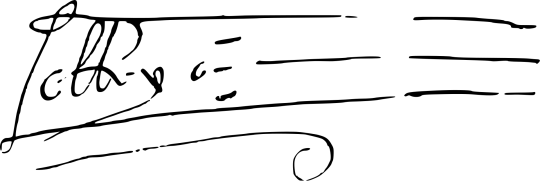
João, the eldest son of King Manuel I to his second wife Maria of Aragon, was born in Lisbon on 7 June 1502. The event was marked by the presentation of Gil Vicente's Visitation Play or the Monologue of the Cowherd (Auto da Visitação ou Monólogo do Vaqueiro) in the queen's chamber.
The young prince was sworn heir to the throne in 1503, the year his youngest sister, Isabel of Portugal, Empress Consort of the Holy Roman Empire between 1527 and 1538, was born.
João was educated by notable scholars of the time, including the astrologer Tomás de Torres, Diogo de Ortiz, Bishop of Viseu, and Luís Teixeira Lobo, one of the first Portuguese Renaissance humanists, rector of the University of Siena (1476) and Professor of Law at Ferrara (1502).
João's chronicler António de Castilho said that, "Dom João III faced problems easily, complementing his lack of culture with a practice formation that he always showed during his reign" (Elogio d'el rei D. João de Portugal, terceiro, do nome). In 1514, he was given his own house, and a few years later began to help his father in administrative duties.

At the age of sixteen, João was chosen to marry his first cousin, the 20-year-old Leonor of Austria,

eldest daughter of Philip the Handsome of Austria-Burgundy

and Queen Joana of Castile,

but instead she married his widowed father Manuel. João took deep offence at this: his chroniclers say he became melancholic and was never quite the same. Some historians also argue this was one of the main reasons that João later became fervently religious, giving him name the Pious (o Piedoso).
On 19 December 1521, João was crowned king in the Church of São Domingos in Lisbon, beginning a thirty-six-year reign characterized by extensive activity in internal and overseas politics, especially in relations with other major European states. João III continued the absolutist politics of his predecessors. He called the Portuguese Cortes only three times and at great intervals: 1525 in Torres Novas, 1535 in Évora and 1544 in Almeirim. During the early part of his reign, he also tried to restructure administrative and judicial life in his realm.
The marriage of João's sister Isabel of Portugal to Holy Roman Emperor Charles V,
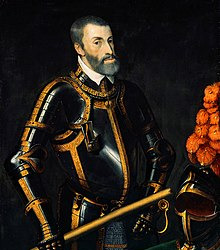
enabled the Portuguese king to forge a stronger alliance with Spain and the Holy Roman Empire. To strengthen his ties with Austria, he married his maternal first cousin Catherine of Austria, younger sister of Charles V and his erstwhile fiancée Leonor, in the town of Crato. João III had nine children from that marriage, but most of them died young. By the time of João's death, only his grandson Sebastião was alive to inherit the crown.
The large and far-flung Portuguese Empire was difficult and expensive to administer and was burdened with huge external debt and trade deficits. Portugal's Indian and Far Eastern interests grew increasingly chaotic under the poor administration of ambitious governors. João III responded with new appointments that proved troubled and short-lived: in some cases, the new governors even had to fight their predecessors to take up their appointments. The resulting failures in administration brought on a gradual decline of the Portuguese trade monopoly. In consideration of the challenging military situation faced by Portuguese forces worldwide, João III declared every male subject between 20 and 65 years old recruitable for military service on 7 August 1549.
Among João III's many colonial governors in Asia were Vasco da Gama,

Pedro Mascarenhas,

Lopo Vaz de Sampaio,

Nuno da Cunha,

Estêvão da Gama,

Martim Afonso de Sousa,
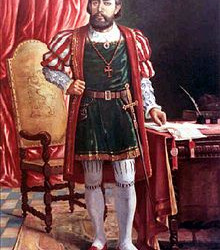
João de Castro

and Henrique de Meneses. Overseas, the Empire was threatened by the Ottoman Empire in both the Indian Ocean and North Africa, causing Portugal to increase spending on defense and fortifications. Meanwhile, in the Atlantic, where Portuguese ships already had to withstand constant attacks of Privateers, an initial settlement of French colonists in Brazil created yet another "front". The French made alliances with native South Americans against the Portuguese and military and political interventions were used. Eventually they were forced out, but not until 1565.
In the first years of João III's reign, explorations in the Far East continued, and the Portuguese reached China and Japan; however, these accomplishments were offset by pressure from a strengthening Ottoman Empire under Suleiman the Magnificent,
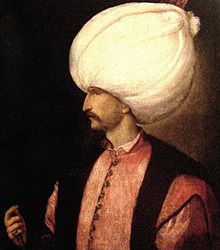
especially in India, where attacks became more frequent. The expense of defending Indian interests was huge. To pay for it, João III abandoned a number of strongholds in North Africa: Safim, Azamor, Alcácer Ceguer and Arzila.
João III achieved an important political victory in securing the control of the Maluku Islands, the "Spice Islands" claimed by Spain since the Magellan-Elcano circumnavigation. After almost a decade of skirmishes in Southeast Asia, he signed the Treaty of Zaragoza with Emperor Charles V on 22 April 1529. It defined the areas of Spanish and Portuguese influence in Asia and established the anti-meridian to the Treaty of Tordesillas.
The reign of João III was marked by active diplomacy. With Spain, he made alliances through marriage that ensured peace in the Iberian Peninsula for a number of years. He himself married Catherine of Austria, the daughter of Philip I of Castile. His sister Isabel of Portugal married Charles V, the king of Spain and Holy Roman Emperor. His daughter Maria Manuela

married King Felipe II of Spain

– and there were others. However, the intermarriage of these closely related royal families may have been one of the factors that contributed to the poor health of João's children and of future King Sebastião of Portugal.
João III remained neutral during the war between France and Spain but stood firm in fighting the attacks of French privateers.
He strengthened relations with the Papal States by introducing the Inquisition in Portugal and the adhesion of the Portuguese clergy to the Counter-Reformation. This relationship with the Catholic Church made it possible for João to name whomever he desired to important religious positions in Portugal: his brothers Henrique and Afonso
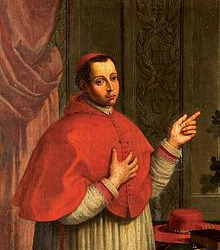
were made Cardinals, and his biological son, Duarte; was made Archbishop of Braga.
Commercial relations were intensified with England, the countries of the Baltic regions and Flanders during João III's reign. Meanwhile, at the other end of the world, Portugal was the first European nation to make contact with Japan. In China, Macau was offered to the Portuguese, and soon Portugal controlled major trade routes in the area. In South Asia, the Portuguese continued its hostile stance against their Muslim rivals and insurgent Indian leaders.
João III's support for the humanist cause was significant. In literature, his active support of Gil Vicente,
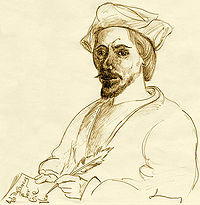
Garcia de Resende,

Sá de Miranda,

Bernardim Ribeiro,
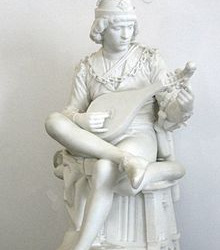
Fernão Mendes Pinto,

João de Barros
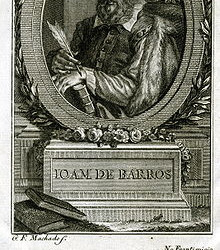
and Luís de Camões
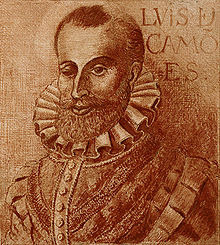
was notable. In the sciences, João III supported the mathematician Pedro Nunes
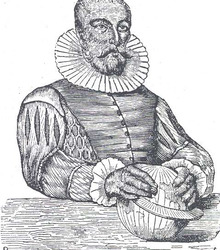
and the physician Garcia de Orta.

Through his links to Portuguese humanists such as Luís Teixeira Lobo, Erasmus dedicated his Chrysostomi Lucubrationes to João III of Portugal in 1527.
The monarch awarded many scholarships to universities abroad, mainly in the University of Paris, where fifty Portuguese students were sent to the Collège Sainte-Barbe headed by Diogo de Gouveia. He definitively transferred the Portuguese university from Lisbon to Coimbra in 1537.

In 1542 João III created in Coimbra a College of Arts (Liberal arts) for which he quickly recalled the many prominent Portuguese and European teachers headed by André de Gouveia at the College of Guienne in Bordeaux. Those included George Buchanan,
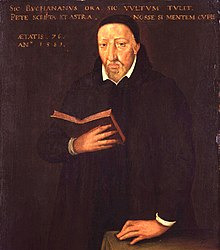
Diogo de Teive, Jerónimo Osório, Nicolas de Grouchy, Guillaume Guérante and Élie Vinet, who were decisive for the dissemination of the contemporary research of Pedro Nunes. The king provided the university with excellent resources. However, the importance of the College was shadowed by rivalry between the orthodox views of the "Parisians" group headed by Diogo de Gouveia and the more secular views of the "Bordeaux" school headed by his nephew André de Gouveia, within the advent of the Counter-Reformation and the influence of the Society of Jesus. The Society of Jesus founded colleges and made education more widely available.
Another noteworthy aspect of João III's rule was the support he gave to missionaries in the New World, Asia and Africa. In 1540, after successive appeals to Pope Paul III asking for missionaries for the Portuguese East Indies under the "Padroado" agreement, João III appointed Francis Xavier to take charge as Apostolic Nuncio. He had been enthusiastically endorsed by Diogo de Gouveia, his teacher at the Collège Sainte-Barbe, and advised the king to draw the youngsters of the newly formed Society of Jesus.The Jesuits were particularly important for mediating Portuguese relations with native peoples.
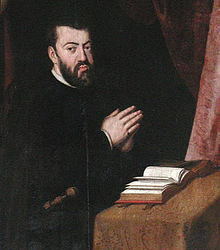
The Inquisition was introduced into Portugal in 1536. As in Spain, the Inquisition was placed under the authority of the king.
The Grand Inquisitor, or General Inquisitor, was named by the Pope after being nominated by the king, and he always came from within the royal family. The Grand Inquisitor would later nominate other inquisitors. In Portugal, the first Grand Inquisitor was Cardinal Henrique the king's brother (who would later himself become king).
There were Courts of the Inquisition in Lisbon, Coimbra and Évora and, from 1560 onwards, in Goa. The Goa Inquisition changed the demographics of Goa considerably. Goa was called the "Lisbon of the Far East" and trade reached a new level.
The Portuguese did not leave Goa undeveloped, rather they introduced modern architecture and built strong roads and bridges that have stood the test of time even till today.
The activities of the Inquisition extended to book censorship, repression and trial for divination, witchcraft and bigamy, as well as the prosecution of sexual crimes, especially sodomy.
Originally created to punish religious deviance, the Inquisition came to have influence in almost every aspect of Portuguese society: politics, culture and social customs. It did serve to spare Portugal the civil upheavals of religious warfare of the sort that occurred in France and elsewhere in Europe during the 16th century.

In João III's time, trade between the Portuguese and Africans was extremely intense in feitorias such Arguim, Mina, Mombasa, Sofala or Mozambique. Under João III, several expeditions started in coastal Africa and advanced to the interior of the continent. These expeditions were formed by groups of navigators, merchants, adventurers and missionaries. Missions in Africa were established by the College of Arts of Coimbra. The objective was to increase the king's dominion, develop peaceful relations and to Christianize the indigenous peoples. Relations with local rulers were often complicated by trade in slaves, as shown by João's correspondence with them.
João III refused to abandon all of the Portuguese North African strongholds, but he had to make choices based on the economic or strategic value of each possession. João III decided to abandon Safim and Azamor in 1541, followed by Arzila and Alcácer Ceguer in 1549. The fortresses of Ceuta, Tangiers and Mazagan were strengthened "to face the new military techniques, imposed by the generalization of heavy artillery, combined with light fire weapons and blades".
João III's court jester was João de Sá Panasco, a black African, who was eventually admitted to the prestigious Order of Saint James based on his service in the Conquest of Tunis (1535).
Before the reign of João III, the Portuguese had already reached Siam (1511), the Maluku Islands (1512), the Chinese littoral (1513), Canton (1517) and Timor (1515). During João's rule, the Portuguese reached Japan, and at the end of João's reign, Macau was offered to Portugal by China. From India, João III imported an amazing variety of spices, herbs, minerals, and fabrics; from Malacca, exotic woods and spice; from Bengala, fabrics and exotic foodstuffs; from Alexandria and Cairo, exotic woods, metals, minerals, fabrics, and boullion; and from China, musk, rhubarb, & silk in exchange for gromwells, pearls, horses from Arabia and Persia, non-worked silk, silk embroidery threads, fruits of the date palm, raisins, salt, sulphur and many other goods.
As Muslims and other peoples constantly attacked Portuguese fleets in India, and because India was so far from mainland Portugal, it was extremely difficult for João III to secure Portuguese dominion in this area. A viceroy (or Governor-General with extensive powers) was nominated, but this was not enough to defend the Portuguese possessions in India. The Portuguese started by creating feitorias – commercial strongholds in Cochin, Cannanore, Coulão, Cranganore and Tanor – with the initial objective of establishing just a commercial dominion in the region.
The hostility of many Indian kingdoms and alliances between sultans and zamorins to expel the Portuguese made it necessary for the Europeans to establish a sovereign state. Portugal thus militarily occupied some key cities on the Indian coast, and Goa became the headquarters of the Portuguese Empire in the East as of 1512. Goa became a starting point for the introduction of European cultural and religious values in India, and churches, schools and hospitals were built. Goa remained an overseas possession of Portugal until India reclaimed it in 1961.
The Portuguese arrived in Japan in 1543. Japan had been known in Portugal since the time of Marco Polo,

who called it "Cipango". Whether Portuguese nationals were the first Europeans to arrive in Japan is debatable. Some say the first Portuguese arrival was the writer Fernão Mendes Pinto, and others say it was the navigators António Peixoto, António da Mota and Francisco Zeimoto.
Portuguese traders started negotiating with Japan earlier than 1550 and established a base there at Nagasaki. By then, trade with Japan was a Portuguese monopoly under the rule of a Captain. Because the Portuguese established themselves in Macau, Chinese commercial relations, mainly the silver trade with Japan, were improved under João III's rule.
After the voyage of Fernão de Magalhães
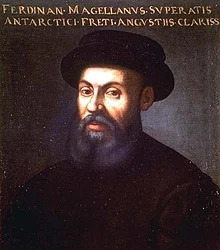
the Crown of Castile claimed the recently discovered Maluku Islands. In 1524, a conference of experts (cartographers, cosmographers, pilots, etc.) was held to solve the dispute caused by the difficulty of determining the meridian agreed to in the Treaty of Tordesillas. The Portuguese delegation sent by João III included names such as António de Azevedo Coutinho, Diogo Lopes de Sequeira, Lopo Homem and Simão Fernandes. The dispute was settled in 1529 by the Treaty of Zaragoza, signed by João III and Carlos I of Spain. The Portuguese paid 350,000 gold ducados to Spain and secured their presence in the islands, which not have been a necessity, as Portugal was actually entitled to the islands according to the Treaty of Tordesillas.
In 1553, Leonel de Sousa obtained authorization for the Portuguese to establish themselves in Canton and Macau. Macau was later offered to João III as a reward for Portuguese assistance against maritime piracy in the period between 1557 and 1564. Malacca, which controlled the eponymous Strait of Malacca, was vital to Portuguese interests in the Far East. After an unsuccessful expedition in 1509, Malacca was finally conquered by Afonso de Albuquerque, the Portuguese viceroy of India, on 24 August 1511. Malacca was later taken by the Dutch in 1641.
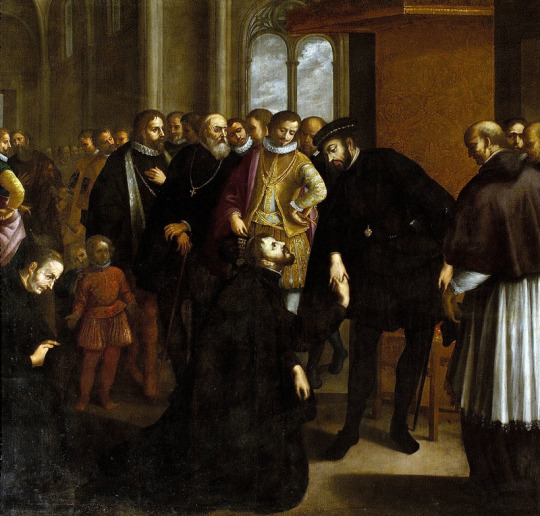
In order to follow its trade routes to the Far East, Portugal depended on the seasonal monsoon winds in the Indian Ocean. In winter, the prevailing northeasterly monsoon impeded travel to India; in summer, the southwest monsoon made departure from India difficult. As a result, Portugal determined that it needed permanent bases in India, in addition to its ports of call in Africa, to pass the time while the wind changed. In addition to Goa, they established themselves in Ceylon (in what is now Sri Lanka) through the conquest of several Ceylonese kingdoms in the sixteenth century. Portuguese Ceylon remained in Portuguese hands until 1658, when it was seized by the Dutch after an epic siege.
During the reign of King João III, the Portuguese Empire established itself in South America with the foundation of the twelve Captaincy Colonies of Brazil (from 1534 onwards). Each with its own donatary captain, the twelve colonies struggled independently. In 1549, João III established the Governorate General of Brazil, and the twelve captaincy colonies became subordinate to it. The first Governor-General appointed by João III, Tomé de Sousa, founded the city of Salvador, Bahia (São Salvador da Bahia de Todos os Santos) in 1549.
Immediately following the discovery of Brazil in 1500, the Portuguese imported brazilwood, Indian slaves and exotic birds from there. Brazilwood was a much appreciated product in Europe, because it could be used to produce a red dye. During João III's rule, after the initial colonization, Portuguese explorers intensified the search for brazilwood and began the cultivation of sugarcane, which was well suited to the climate of Brazil, especially around Recife and Bahía.
In the final years of João's reign, Portugal's colony of Brazil was just beginning its rapid development as a producer of sugar that compensated for the gradual decline of revenues from Asia, a development that would continue during the reign of his grandson and successor, Sebastião (1557–1578). Since Brazil lacked a large native population, and the Indians did not make good plantation workers, the Portuguese colonists began to import African slaves to work their plantations. The first slaves, from the region of Guinea, arrived in Brazil in 1539. Most of them worked in the sugarcane fields or served as house servants.
From 1539, the heir to the throne was João Manuel, Prince of Portugal,

who married Joana of Austria, Princess of Portugal,

daughter of Charles V. The sole son of João III to survive childhood, Prince João, was sickly and died young (of juvenile diabetes), eighteen days before his wife gave birth to Prince Sebastião on 20 January 1554. When João III died of apoplexy in 1557, his only heir was his three-year-old grandson, Sebastião. João III's body rests in the Monastery of Jerónimos in Lisbon, next to his wife.
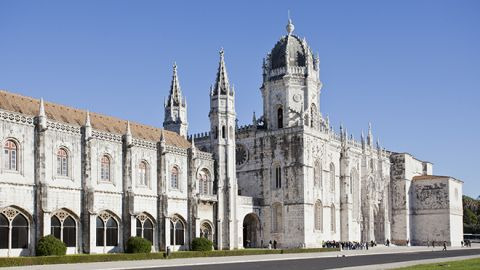

With his wife Catarina of Austria (married 10 February 1525) he had 9 nine children:
Prince Afonso (24 February 1526 - March 1526) Prince of Portugal (1526).
Princess Maria Manuela (15 October 1527 - 12 August 1545) Princess of Portugal (1527–1531). Princess consort of Asturias by marriage to King Philip II of Spain, then Prince of Asturias. She had one deformed child, Prince Carlos, and she died a few days after his birth.
Infanta Isabel (28 April 1529 - 28 April 1529)
Infanta Beatriz (15 February 1530 - 15 February 1530)
Prince Manuel (1 November 1531 - 14 April 1537) Prince of Portugal (1531–1537). Declared heir in 1535.
Prince Filipe (25 March 1533 - 29 April 1539) Prince of Portugal (1537–1539). Declared heir in 1537.
Infante Dinis (6 April 1535 - 1 January 1537)
Prince João Manuel (3 June 1537 - 2 January 1554) Prince of Portugal (1537–1554). Declared heir in 1539. Married Joana of Spain. Their son became King Sebastião I.
Infante António (9 March 1539 - 20 January 1540)
8 notes
·
View notes
Text
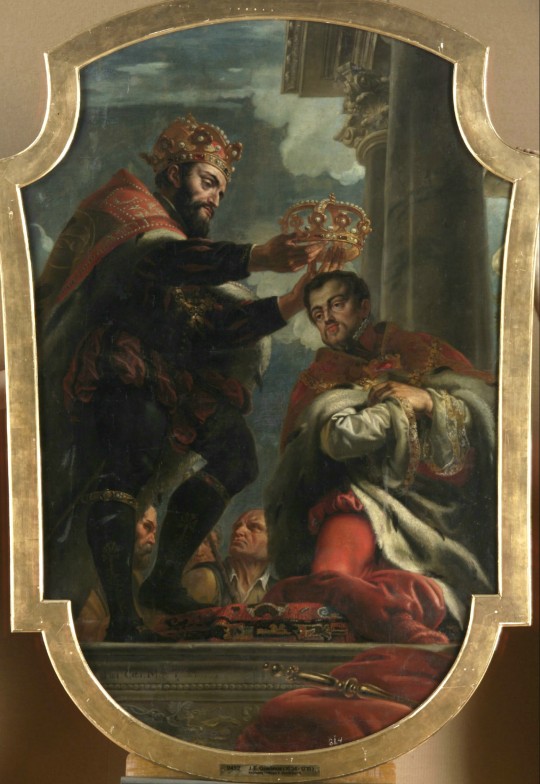
Charles V crowns Philip II. By Jan Erasmus Quellinus.
#monarquía española#reino de España#reyes de españa#casa de austria#carlos v#felipe ii#rey de españa#viva el rey#kingdom of spain#house of habsburg#jan erasmus quellinus
8 notes
·
View notes
Text




Through the Years → Felipe VI of Spain (2,592/∞) 3 April 2021 | King Felipe VI of Spain during the Spanish Copa del Rey match between Athletic de Bilbao v Real Sociedad at the la cartuja Stadium in Sevilla Spain (Photo by David S. Bustamante/Soccrates/Getty Images)
1 note
·
View note
Text



On Saturday, King Felipe VI of Spain and King Harald V of Norway attended the 38th Copa del Rey Mapfre Sailing Cup awards ceremony in Palma de Mallorca, Spain. August 3, 2019.
23 notes
·
View notes
Photo

Felipe VI ha entregado este jueves en el monasterio de Yuste (Cáceres) el Premio Europeo Carlos V, que otorga la Fundación Academia Europea e Iberoamericana de Yuste, a la excanciller de Alemania Angela Merkel. «Es un gran honor para mi recibir esta gran distinción», ha expresado tras recibir el galardón y antes de dedicar un discurso a la idea de Europa como «comunidad de paz». El Rey Felipe VI, por su parte, ha destacado el «pragmatismo y fiabilidad» de la canciller Angela Merkel, que han sido «símbolo de solidez en Europa y en el mundo». El monarca ha resaltado su «espíritu científico, su aguda capacidad analítica, su coherencia y su capacidad de compromiso alejada de protagonismos y de los extremos que le han permitido alcanzar consensos y encontrar soluciones equilibradas». El jurado de la XIV Premio Europeo Carlos V decidió otorgar el galardón a Merkel como «reconocimiento a su larga trayectoria política al servicio de Europa, habiendo sido una firme defensora del proceso de integración europea y del importante papel estratégico de Europa en el concierto internacional». De esta forma, la canciller alemana se convierte en la tercera mujer que recibe el Premio Europeo Carlos V tras la que fuera presidenta del Parlamento Europeo, Simone Veil, quien recibió el Premio Europeo Carlos V en 2008, y la impulsora del programa Erasmus, Sofia Corradi, que recibió el galardón en 2016. Además, es la segunda vez que el galardón recae en un canciller de la República Federal de Alemania, tras Helmut Kohl en 2006. Cuacos de Yuste, Comarca de la Vera, Cáceres, Extremadura, España. 14/10/2021. (en Cuacos, Extremadura, Spain) https://www.instagram.com/p/CVAqon2Ijsq/?utm_medium=tumblr
0 notes
Photo




Felipe and Letizia retrospective: September 27th
2004: Opening of the International Seminar on ‘Spain, Bridge between the European Union and Latin America’; Lunch offered to the President of Czhec Republic Vaclav Klaus and his wife Livia Klausova& Gala dinner offered to the President of Czhec Republic Vaclav Klaus and his wife Livia Klausova. (1, 2)
2007: Posthumous tribute to Don Rodrigo Uría
2010: Audiences at la Zarzuela
2012: Inauguration of the Tourism International Day 2012 in Gran Canaria; Visited La Gomera & Letizia on the cover of Tiempo magazine with other women that turned 40 in 2012 (1, 2)
2013: 25th anniversary of the class of 1988 in Pontevedra & Visited King Juan Carlos at Quiron Hospital
2015: Went out to dinner
2017: “4th edition of the Enrique V. Iglesias Prize for the Development of the Ibero-American Business Space” & Opened the Professional Training Course 2017/2018, in Teruel (1, 2)
2018: 3rd session of the Spain Trends Forum, organized by El País and the consultancy Kreab in Madrid & Opened the Professional Training Course 2018/2019, in Marratxí (1, 2)
2019: Visited the Museum of Aeronautics and Astronautics in Madrid, Presentation of the #Femtástica Project, created by the Foundation to Help Against Drug Addiction and Samsung & Visited Arganda del Rey in Madrid that was affected by the recent floods
F&L Through the Years: 427/??
#King Felipe#Queen Letizia#King Felipe of Spain#Queen Letizia of Spain#King Felipe VI#King Felipe VI of Spain#F&L Through the Years#September27
6 notes
·
View notes